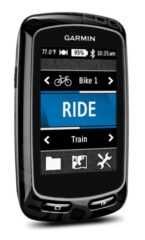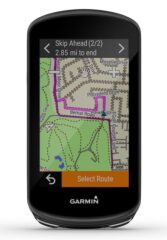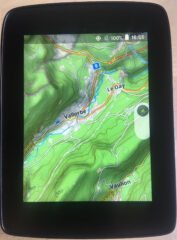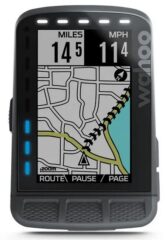Garmin’s previous top-end cycling computer, the Edge 1030, was released in late 2017, so it’s no surprise that they announced an updated version in June 2020, the Edge 1030 Plus. I was expecting more from the new model including a better screen, but this suggests that the real update, possibly called the Edge 1040 or 1200, should arrive in 2021, so I recommend waiting if you don’t have an immediate need for a top-end unit with an extra-large screen.
The Edge 1030 had the best screen and map display of any cycling-specific GPS device when it launched in 2017 (see my review here), but since then several competitors have raised the bar. The fact that the Edge 1030 Plus uses the same screen as the 1030 is therefore disappointing.

Historically, Garmin have updated their top-end Edge model every 3 to 3.5 years with a new body and screen: Edge 705 = released late 2007, Edge 800 = late 2010, Edge 1000 = early 2014, Edge 1030 = late 2017 (thanks to GPSrumors for these dates).
This list lacks one top-end model: The Edge 810, which was released in early 2013. The 810 had the same body and screen as the 800, which was released 2.5 years earlier, but the 810 added cell phone connectivity via Bluetooth. The Edge 1000 was released about one year later with a much better screen. The release of the Edge 1030 Plus seems to parallel that of the 810, consisting mainly of a chipset upgrade 2.5 years after the initial device was released, so expecting a truly new device to be launched in about 12 months is quite reasonable.
Garmin Edge 1030 Plus

The Garmin Edge 1030 Plus is the same price as the 1030 when it launched, at virtually US$600, making it the most expensive device listed here. The main change compared to the Edge 1030 is that the Plus model has the new Sony processor that was first used in the Edge 830 that was launched in 2019. Other improvements include battery life (up to 24 hours), although that was already very good in the Edge 1030 (16-20 hours). The touchscreen sensitivity has reportedly been improved on the Edge 1030 Plus, which was certainly not great on the 1030.
Most of the other new features that Garmin announced for the Edge 1030 Plus were actually added to the regular 1030 in 2019 via firmware updates once the Edge 830 and 530 devices were launched with those features.
Compared to the standard Edge 1030, the new 1030 Plus gets more pre-loaded map regions and Garmin have made it much easier and free to download new map regions, which was previously only possible using 3rd party websites. Related to this, the 1030 Plus has twice the storage capacity of the 1030. However, this is not a major improvement because the 1030’s memory could be expanded with an SD card, which was a useful option.
The SD card option on the Edge 1030 could be used not only as memory expansion but also as a secure ride storage method. I’ve had Garmin Edge models completely fail before (two Edge 1000s were replaced under warranty in two years), so I’ve learnt to record rides to the SD card instead of the internal memory so that even when files on the device can no longer be accessed, data on the SD card remains intact. Fortunately, I’ve never had such a problem with the Edge 1030, but I’d still prefer to maintain the option of storing my ride data outside of the device.
The biggest disappointment of the new Edge 1030 Plus is the lack of a screen upgrade. Garmin has fallen behind the competition in this regard, so I now look at where the competition is.
Hammerhead Karoo
I’ve been using a Hammerhead Karoo for the last 6 months with VERY mixed feelings. The Karoo has a cell-phone quality screen with very high resolution and excellent touchscreen sensitivity. It’s the same screen size as the Edge 1030 (3.5 inches), but the squarer aspect ratio makes it slightly less usable with not as much of the upcoming route visible on the map because the screen is not as tall.
The Karoo is 50% thicker and heavier than the Edge 1030, so it’s a massive device and needs a solid mount to keep it steady. The bulk is needed to house the battery required by the high-resolution screen, but battery life is still not great (under 10 hours compared to 16+ hours on the Edge 1030 in my experience).
If Hammerhead could match Garmin in terms of the user interface, routing, map rendering and other features then there would be no competition as to which unit was better, but Garmin has over a decade’s worth of extra experience and it shows – the Edge 1030 is a more complete and finished product. For me, the only battles that Karoo are currently winning are in terms of screen resolution and responsiveness.

Despite the quality of the Karoo’s screen, the map rendering doesn’t take full advantage of this, so map reading can actually be easier on the Garmin Edge 1030. However, the Karoo is running an Android phone operating system and if you spend a morning reading internet forums you can figure out how to access the Android OS and install other map software. I’ve therefore been able to install the OsmAnd+ app, which has amazingly detailed and beautifully rendered maps (with elevation contours and hill shading if you have the extra plug-ins, as shown in the image).
After these serious modifications, different mapping apps can be switched between depending on the desired functionality, but unfortunately the standard map that is integrated into the rest of the cycling data screens is rather poor. This must be improved if Karoo want to properly challenge Garmin for the best navigation-focused bike GPS. The Karoo also only has 8 GB of non-expandable storage for maps, compared to 32 GB on the Edge 1030 Plus.
The Karoo’s hardware and software have the potential to get better and better but in their current state I wouldn’t recommend the Karoo over the Edge 1030. Hammerhead are trying to catch up to Garmin quickly in terms of the interface, functionality and navigation and so firmware updates are regularly available that include significant improvements. In addition, they’ve sold out of the first-generation Karoo (which was originally $500 but was often sold at $400) and have started to tease the second-generation device to be released “in 2020”.
Other Devices with 3.0+ Inch Screens
I’m a fan of large-screen cycling GPS computers, but I feel that the 3.5 inch screen of the Garmin Edge 1030 and Hammerhead Karoo are at a sensible level and anything larger would be overkill. There are two such options, the Mio Cyclo 605 (4.0 inches) and OS Trail 2 Bike (3.7 inches). These are each around $500 but are only available in certain markets and with certain map regions and neither appears to do anything better than either the Edge 1030 (Plus) or Karoo, so I wouldn’t recommend them.
The Sigma ROX 12.0 is an interesting option with a slightly smaller screen than the Edge 1030 (3.0 inches), but the screenshots and videos (e.g., see the DC Rainmaker review) show the map rendering and screen brightness to possibly be better than Garmin’s. Like the Karoo, it’s based on the Android operating system. Initial reviews on the device’s performance have been mixed, with incomplete routing and navigation options according to this review.
At $350 the Sigma Rox 12.0 is much cheaper than the larger devices, so it could be a good budget option. However, Garmin now offer an updated version of the Edge 1000 that also has a 3.0 inch screen and is priced at only $250, the Edge Explore, but a few of the more training-focused features have been removed.
Wahoo Element Roam

Wahoo have taken a lot of Garmin’s cycling market share in the past few years. They finally launched a model with a colour screen in early 2019 with the Elemnt Roam ($380). However, the Roam’s screen size (2.7 inches diagonally) is still a long way short of the Edge 1030 and Karoo and it’s instead in the same size category as the Garmin Edge 530 ($300) and Edge 830 ($400) (both 2.6 inches), so the Wahoo’s screen is certainly not causing Garmin any concerns.
Many people have chosen Wahoo because of reliability concerns with Garmin Edge devices. Even though there were far too many reports of issues and failures with the Edge 810, 1000, and Edge 820, the current range of Edge computers (1030, 830, 530, 130) seem to not have any inherent problems. It shouldn’t be ignored that there is a significant sampling bias because Garmin is the market leader, so they have more devices out there that could go wrong. In addition, Garmin’s customer support is generally pretty good when needed.
Some people choose Wahoo over Garmin because of Wahoo’s high level of integration with their phone app. Personally, this puts me off of Wahoo because I want an entirely stand-alone device.
Overall, there are some valid reasons to use a Wahoo instead of a Garmin but if you’re looking for the biggest and best screen then Wahoo is not a very appealing option. If you want a slightly smaller screen size then the Wahoo Elemnt Roam or Garmin Edge 830 are certainly the two main options at similar prices; the user interface and phone integration being the most important distinguishing factors.
Lower-Priced Devices with 2.5-3.0 Inch Screens
Polar, Bryton, Lezyne and Stages all offer GPS devices with screens in the 2.7 to 2.8 inch range that are cheaper than the Garmin Edge 830 or Wahoo Elemnt Roam.
At just $200 the Lezyne Mega XL is a good budget option with a reasonably large screen, but unfortunately it’s only black-and-white.
For $300, the Bryton Rider 860 has a 2.8 inch color screen and runs an Android-based OS with a good map display, but the Garmin Edge Explore ($250) and Edge 530 ($300) are very competitive options at a similar price.
Conclusions
I bought the Garmin Edge 800, 1000, and 1030 shortly after each was available to have the largest and best mapping experience available on a bike GPS at the time. Other options have since exceeded the Edge 1030 in terms of screen size and resolution (e.g., the Hammerhead Karoo), but Garmin have not upgraded the screen in their recently-announced top-end Edge computer, the Edge 1030 Plus.
I’ll therefore be waiting for the real hardware update in the next Garmin Edge model that will hopefully launch in 2021 (expected to be called the Garmin Edge 1040 or 1200) and should include a higher-definition and more vibrant screen to keep ahead of the competition in that regard.
The Hammerhead Karoo (and soon-to-be-released Karoo 2) has a better screen than any Garmin Edge, but I’ve found that the map rendering in the standard setup and other functions still keep this behind Garmin’s offerings in terms of usability.
There is a lot more competition in the next screen size category down, with the Wahoo Elemnt Roam and Edge 830 both being excellent devices, plus there are a few lower-priced options that are worth considering.
The Garmin Edge 1030 Plus is certainly an improvement over the Edge 1030 and so it takes the mantle of the best large-screen GPS cycling computer currently available. Even so, the glaring omission of an improved screen means that a Garmin unit with better hardware cannot be far off if Garmin want to keep up with the ever-expanding competition.
Note: Prices are suggested retail prices in US dollars, without sales tax and were valid in early 2020.
Full disclosure: I’ve paid for the Garmin and Hammerhead units myself. I’ll receive a small commission if you buy something after clicking on an Amazon link.
I think this article is a little biased towards Garmin.
“Overall, there are some valid reasons to use a Wahoo instead of a Garmin but…….”, but none of them were covered in the artcle.
“The Hammerhead Karoo ….. I’ve found that the map rendering in the standard setup and other functions still keep this behind Garmin’s offerings in terms of usability”, yet most reviews I’ve read claim navigation is its real strength where Garmin mediocre.
I’m a Garmin Edge 1000 owner since many years; I’m ready to switch based on constant bugs (Device frequently powers off by itself during use) and not very intuitive navigation.
I’ve currently got my eye on the Karoo 2.
Hi Gavlar. This article is about the new Garmin Edge 1030 Plus rather than being advertised as a complete comparison of all competing products, so it’s not surprising that the focus is on that product.
I agree with you that the Edge 1000 was one of Garmin’s poorer products with more reliability problems than most of their models (I even mentioned this in the article); the Edge 1030 was a significant improvement and the 1030 Plus appears to be better again.
Regarding the Karoo, navigation might be a strength of the Karoo if you enjoy having the device tell you when to turn, but I normally load a route onto the device and simply want a line to be displayed on the map that I can choose to follow or not without the device telling me to do. In that scenario, the readability of the map display on the Karoo is disappointing despite the screen being such excellent quality due to the map rendering used. My Karoo 1 has received all the interface updates that will be on the Karoo 2 but I cannot see that the map display has been improved at all. Hopefully that will receive another update before the Karoo 2.
You said that I didn’t cover what valid reasons someone might choose Wahoo over Garmin, but in the 2 paragraphs before your quoted sentence I mentioned “Wahoo’s high level of integration with their phone app” and “Many people have chosen Wahoo because of reliability concerns with Garmin Edge devices”; those are two valid reasons for some people. Neither of them are convincing for me because I prefer to keep my phone and GPS independent and the current range of Edge devices don’t really have inherent reliability concerns. [edited for typos]
Ok agreed
Now, after the Epix 2, amoled display in Edge 1040? might be possible? I have Epix 2 and it has a very nice screen… I’d love that on a new edge
Let’s hope so. It’s now almost 2 years after the 1030 Plus was released and 5 years since the screen on the 1030 and 1030 Plus was first used. It’s definitely time for something new here. Hopefully chip shortages and shipping times aren’t disrupting Garmin too much – they’ve been launching products in other categories recently.